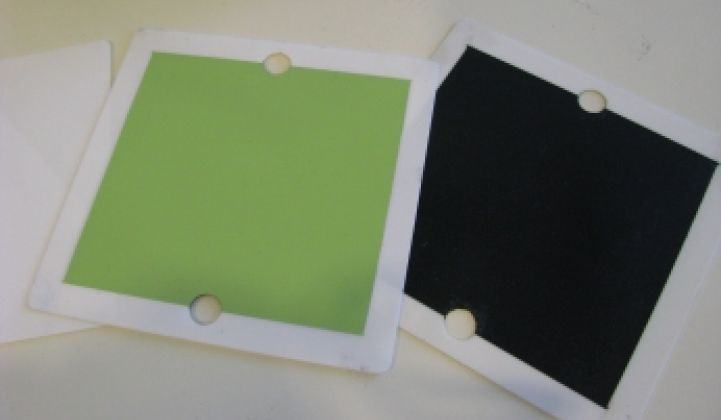San Jose--Bloom Energy made its long-anticipated debut today and while the company didn't share all of the details behind its so-called energy servers, it did give some.
An energy server can provide 100 kilowatts of power by converting natural gas or other hydrocarbons into electricity pretty much on demand. A single server is about the size of an industrial shipping crate, consists of four 25 kilowatt modules, and costs $700,000 to $800,000. In all, that means power for 9 to 10 cents after incentives in California.
But how does it work inside and what makes Bloom's better than the fuel cells designed by others? CEO and founder K.R. Sridhar gave us an explanation in the video. The picture shows two of the internal ceramic plates.
Sridhar (in the video and earlier in the day) also explains how Bloom may enhance the fuel cell in the future for a push into the domestic market in about a decade and the enhancement represents both a step forward and a step back. Carbon dioxide and water are byproducts of the gas-to-electricity reaction. By adding some additional "plumbing" components, the fuel cell can capture the water, run it through the fuel cell later and produce hydrogen. Hydrogen could then be stored until needed to power a car or provide electricity to a home.
The water-to-hydrogen reaction will require additional electricity. Bloom suggests that solar panels can provide this power. Although the fuel cell could do this reaction now, Bloom isn't putting in the components because the market isn't ready, said Sridhar. So having a path to energy storage: a step forward.
So what is the step back? Bloom's patents discuss taking both the carbon dioxide and hydrogen, running them through the fuel cell and producing a methane-like fuel. In other words, Bloom -- at least for now -- doesn't appear to be looking at recycling carbon dioxide for the big architectural jump into the consumer market ten years from now.
"It is simpler" to just concentrate on hydrogen, Sridhar said.
Recycling carbon dioxide is a dream of many; it also remains a thorny scientific challenge. ARPA-E gave $23.7 million in grants to companies who hope to make fuel from sunlight and carbon dioxide. Maybe discretion is the better part of valor here. Besides, if someone else, such as BioCee or Sun Catalytix, can crack the carbon dioxide-to-fuel formula, Bloom may be able to license it. (Another highlight: Sridhar confirmed that zirconia, also called zirconium dioxide, is a key ingredient, confirming our earlier review of the patents.)
There's an interesting connection between Bloom and Hara, the carbon management software company. Kleiner Perkins invested in both companies and both listed Coca-Cola as a signature client. In fact, Fortune 500 friends played an integral part of the launches of both companies. It gives the companies credibility. However, if Kleiner relies on the same names too much, it may begin to take the sheen off the impact. So look for the big names at the next Kleiner launch -- and cross-check them with the rest of the portfolio.
And finally, here's a video of the servers themselves:



